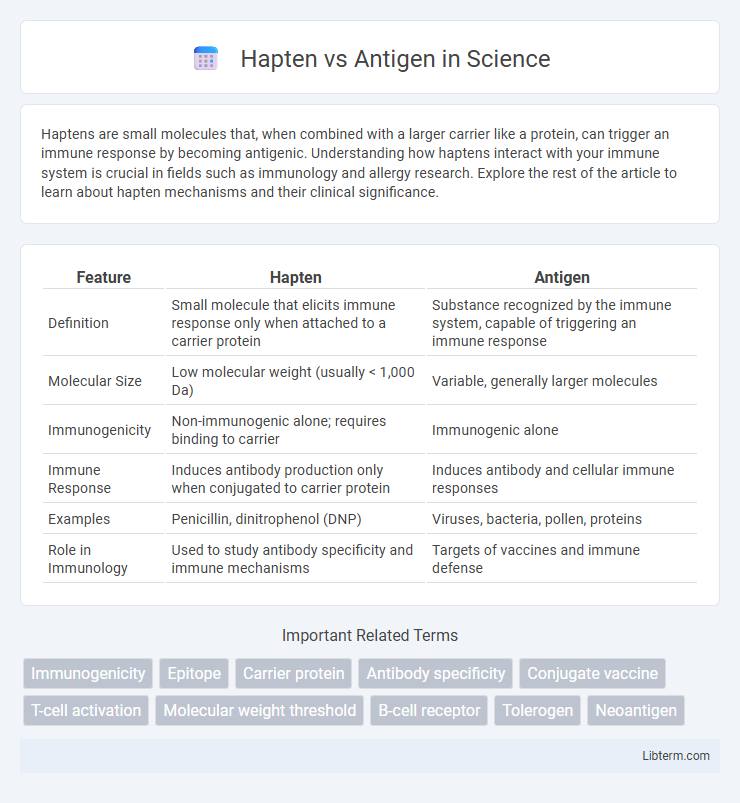Haptens are small molecules that, when combined with a larger carrier like a protein, can trigger an immune response by becoming antigenic. Understanding how haptens interact with your immune system is crucial in fields such as immunology and allergy research. Explore the rest of the article to learn about hapten mechanisms and their clinical significance.
Table of Comparison
| Feature | Hapten | Antigen |
|---|---|---|
| Definition | Small molecule that elicits immune response only when attached to a carrier protein | Substance recognized by the immune system, capable of triggering an immune response |
| Molecular Size | Low molecular weight (usually < 1,000 Da) | Variable, generally larger molecules |
| Immunogenicity | Non-immunogenic alone; requires binding to carrier | Immunogenic alone |
| Immune Response | Induces antibody production only when conjugated to carrier protein | Induces antibody and cellular immune responses |
| Examples | Penicillin, dinitrophenol (DNP) | Viruses, bacteria, pollen, proteins |
| Role in Immunology | Used to study antibody specificity and immune mechanisms | Targets of vaccines and immune defense |
Introduction to Haptens and Antigens
Haptens are small molecules that, by themselves, cannot trigger an immune response but become immunogenic when attached to a larger carrier protein, forming a complex recognized by the immune system. Antigens are substances or molecules, often proteins or polysaccharides, that are inherently capable of eliciting an immune response by binding specifically to antibodies or immune cells. Understanding the distinction between haptens and antigens is critical for immunology, vaccine design, and allergy research.
Fundamental Definitions
Haptens are small molecules that, by themselves, cannot elicit an immune response but become immunogenic only when attached to a larger carrier protein. In contrast, antigens are substances capable of directly triggering an immune response by binding specifically to antibodies or T-cell receptors. The fundamental distinction lies in haptens' requirement for a carrier molecule to be recognized by the immune system, whereas antigens independently possess the structural complexity to activate immune cells.
Structural Differences
Haptens are small molecules that lack immunogenicity on their own but can elicit an immune response only when conjugated to a larger carrier protein, whereas antigens are typically larger molecules capable of directly triggering an immune response. Structurally, haptens are low molecular weight compounds, often less than 1,000 Daltons, while antigens generally possess complex three-dimensional structures with multiple epitopes recognized by immune receptors. The key difference lies in the size and complexity: antigens have diverse molecular patterns enabling direct recognition by antibodies or T cells, while haptens require covalent binding to a carrier to form an immunogenic complex.
Immunogenicity Comparison
Haptens are small molecules that are not immunogenic by themselves but become immunogenic when covalently attached to a larger carrier protein, enabling an immune response. Antigens, typically larger molecules such as proteins or polysaccharides, inherently possess immunogenic properties that can stimulate antibody production independently. The immunogenicity comparison highlights that haptens require a carrier for effective immune recognition, whereas antigens naturally trigger immune activation due to their size and structural complexity.
Role in Immune Response
Haptens are small molecules that do not elicit an immune response alone but become immunogenic when attached to a carrier protein, enabling antibody production. Antigens are substances recognized by the immune system as foreign, directly triggering immune responses by activating B cells and T cells. The key difference lies in the size and complexity needed to stimulate immune recognition, with haptens requiring conjugation and antigens acting independently.
Examples of Haptens and Antigens
Haptens are small molecules that elicit an immune response only when attached to a larger carrier protein, with examples including penicillin, urushiol from poison ivy, and dinitrophenyl. Antigens are substances that directly trigger the immune system, such as bacterial toxins, viral proteins, and pollen grains. Common antigens include influenza virus hemagglutinin and Staphylococcus aureus surface proteins.
Mechanisms of Antibody Formation
Haptens are small molecules that cannot elicit an immune response independently but become immunogenic when covalently attached to a carrier protein, forming a hapten-carrier complex recognized by B cells. Antigens are larger molecules capable of directly stimulating antibody formation by activating B cells and helper T cells through antigen presentation and receptor binding. The immune mechanism involves hapten-carrier conjugates internalized by antigen-presenting cells, leading to T cell activation, whereas antigens inherently provide epitopes for B cell receptor binding and subsequent antibody production.
Clinical Significance and Applications
Haptens are small molecules that elicit an immune response only when attached to a larger carrier protein, making them crucial in drug allergy testing and vaccine development by identifying specific immune reactions. Antigens, as larger molecules or pathogens recognized by the immune system, serve as primary targets in diagnostic assays, immunotherapies, and vaccine formulations. Understanding the distinction between haptens and antigens enhances precision in designing immunoassays and therapeutic strategies for autoimmune diseases and hypersensitivity reactions.
Challenges in Diagnosis and Research
Haptens, small molecules that elicit an immune response only when attached to a larger carrier protein, present challenges in diagnosis due to their inability to trigger an immune reaction independently, complicating the identification of specific immune responses. Antigens, being larger and capable of provoking an immune response alone, are more straightforward to detect, but the structural diversity and cross-reactivity of antigens often hinder precise diagnostic differentiation. Research difficulties arise from the need to isolate hapten-carrier complexes and understand the specific molecular interactions involved, which are critical for developing accurate immunoassays and targeted therapies.
Summary and Key Takeaways
Haptens are small molecules that cannot trigger an immune response independently but become immunogenic when attached to larger carrier proteins, whereas antigens are substances capable of inducing an immune response on their own. Both are recognized by antibodies, but only antigens can elicit full immune activation without conjugation. Understanding the distinction between haptens and antigens is critical in immunology for vaccine development and allergy research.
Hapten Infographic

 libterm.com
libterm.com